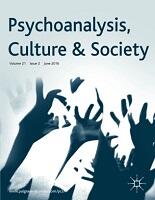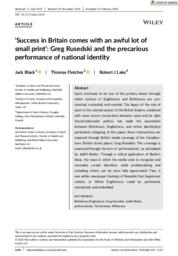Fletcher, Thomas
Person Preferred Name
Thomas Fletcher
Related Works
Content type
Digital Document
Abstract
In view of scholarly work that has explored the socio-psycho significance of national performativity, the body and the “other,” this article critically analyses newspaper representations of the Canadian-born British tennis player Greg Rusedski. Drawing on Lacanian interpretations of the body, it illustrates how Rusedski’s media framing centered on a particular feature of his body – his “smile.” In doing so, we detail how Rusedski’s “post-imperial” Otherness – conceived as a form of “extimacy” (extimité) – complicated any clear delineation between “us” and “them,” positing instead a dialectical understanding of the splits, voids and contradictions that underscore the national “us.”
Origin Information
Content type
Digital Document
Abstract
Sport continues to be one of the primary means through which notions of Englishness and Britishness are constructed, contested, and resisted. The legacy of the role of sport in the colonial project of the British Empire, combined with more recent connections between sport and far right fascist/nationalist politics, has made the association between Britishness, Englishness, and ethnic identity(ies) particularly intriguing. In this paper, these intersections are explored through British media coverage of the Canadian-born, British tennis player, Greg Rusedski. This coverage is examined through the lens of ‘performativity,’ as articulated by Judith Butler. Through a critical application of Butler's ideas, the ways in which the media seek to recognise and normalise certain identities, while problematising and excluding others, can be more fully appreciated. Thus, it was within newspaper framings of Rusedski that hegemonic notions of White Englishness could be performed, maintained, and embedded.
Origin Information
Content type
Digital Document
Abstract
"Scholars working in the academic field of sport studies have long debated the relationship between sport and gender. Modern sport forms, along with many related activities, have been shown to have historically supported ideals of male superiority, by largely excluding women and/or celebrating only men's athletic achievements. While the growth of women's sport throughout the 20th and 21st centuries has extinguished the notion of female frailty, revealing that women can embody athletic qualities previously thought exclusive to men, the continuation of sex segregation in many settings has left something of a discursive 'back door' through which ideals of male athletic superiority can escape unscathed, retaining their influence over wider cultural belief systems. However, sex-integrated sport potentially offers a radical departure from such beliefs, as it challenges us to reject assumptions of male superiority, entertaining very different visions of sex difference and gender relations to those typically constructed through traditional models of physical culture. This comprehensive collection offers a diverse range of international case studies that reaffirm the contemporary relevance of sex integration debates, and also articulate the possibility of sport acting as a legitimate space for political struggle, resistance and change."--From the publisher description.
Origin Information
Content type
Digital Document
Abstract
Scholars working in the academic field of sport studies have long debated the relationship between modern sport and gender (e.g. Hargreaves and Anderson, 2014; Hargreaves, 1994; Lenskyj, 1986; Messner, 2002). Within this body of work, modern sport forms – along with a great diversity of related activities, including dance, fitness training, physical education, etc. – have consistently been shown to carry meanings relative to the structures of gender prevailing in the wider social settings within which they take place, with patterns of participation and consumption clearly mapping onto gendered ideals. However, rather than simply mirroring such social norms, research suggests that many sporting practices were invented or have been purposefully developed in order to train young men and women in socially-approved gender behaviors to begin with (Cahn 1994; Hargreaves 1994; Theberge, 2000). Thus, much of contemporary physical culture finds its roots in the process which scholars describe as the ‘social construction of gender’; in other words, doing sports and other activities in gender-differentiated ways has long been a means of producing and maintaining difference in the lives of men and women, girls and boys.
Origin Information




